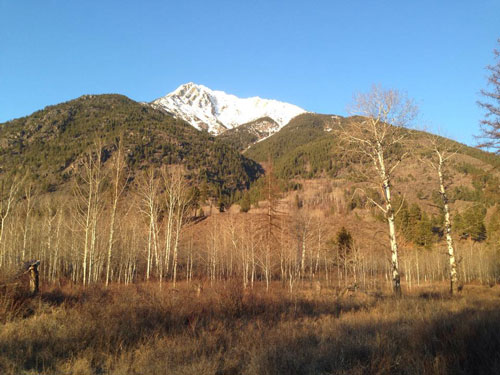
I just came back from Clear Sky Meditation and Study Centre where I attended a Holistic Land Management course with Jeff Goebel of About Listening. I went expecting the unexpected and I was delightfully and vigorously inspired.
Conflict over resources
Clear Sky is in the middle of my favorite place on earth: the Rocky Mountain Trench in the SE corner of British Columbia known as the East Kootenays. It has everything that tugs my heart: spectacular scenery, a western serengeti hosting a diverse population of wildlife, and grasslands. It also crushes my heart seeing conflict between people over resources from all-terrain vehicles causing land degradation, poor logging practices that scar the land, conflicts between domestic grazers and wildlife, forest ingrowth and poorly planned urban development, all reducing our precious grasslands. It is a land in conflict, it is people in conflict. It is such a complex problem, and despite so many attempts to fix it, the land and people remain unhealed.
Holistic Management tools for creating positive change from conflict
I am always searching for tools and skills to push me forward to find a way to make a difference, hence my interest in Holistic Land Management. The unexpected part of this training was spending the first day learning to listen with respect and using this tool to understand and work through conflict. It created a caring, trusting, and harmonizing atmosphere between ranchers and a diverse group of individuals. It was an empowering day. There was some anxiety at the end of the day, some wanting less heart and soul and more of a meat and potatoes approach to land management.
The second day was a continuation and wrap up of communication skills, and a series of stories from Jeff about his approach and working through conflict in his gentle, respectful manner, that has lead to reversals of farm/ranch/community practices, increased productivity and a healing of both the land and its people. This holistic approach looks at increasing social, economic, and ecological prosperity. We spent the afternoon walking though the local grasslands, looking at ecological health, and listening to the land.
The last day we used our new tools to look at the regional issues of the Rocky Mountain Trench. We all shared different views, with a common theme of love for the land and feeling the pain from its conflicts. We identified worst-case scenarios, best-case scenarios, and beliefs and actions.
I have struggled for the past few decades with how to create effective, positive change in the Rocky Mountain Trench. It led me to go away to graduate school at Utah State University to study landscape architecture and environmental planning. It focused my research on the area and the conflicts, but I never felt that I had a way to make a valuable contribution to the problems.
Vision for a land use plan for the Rocky Mountain Trench
I have since been working with nonprofit groups creating master plans and shaping their visions. I continue to learn about grasslands and ecological change and apply that to my work. But my vision hasn’t changed from creating a land use plan of the Rocky Mountain Trench that holistically addresses its past, its current situation, and the future. My vision heals the land and its people: unifying, respecting, listening and creating a better future, economically, spiritually, ecologically and socially. Pretty big dreams and I think the framework that Jeff Goebel helped me learn might actually make it possible.
—Leslie Lowe, Registered Landscape Architect